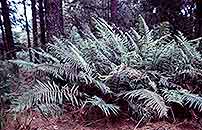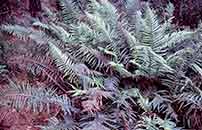Polystichum macleae (Baker) Diels
Synonyms |
Aspidium macleae Baker |
|---|---|
Common name |
|
Description |
Rhizome erect or shortly creeping; rhizome scales midbrown, margins entire, lanceolate-linear in outline, apex gradually tapering to a point, up to 20 mm long. Fronds tufted. Stipe 20-55 cm long, strawcoloured, scales squarrose, pale brown, ovate in outline, with dark brown central band, denser and becoming darker towards the base. Lamina 18-60 x 9.5-24 cm, ovate to lanceolate-oblong in outline, pinnate. Pinnae linear-oblong in outline, apex gradually tapering to a point, bases unequally cuneate with a well-developed acroscopic basal auricle, both surfaces sparsely set with brown, fimbriate or ribbon-like scales, denser along the costae, margins toothed, sometimes doubly. Rhachis as for stipe but scales smaller and narrower. Sori circular, numerous, 0.75-1.5 mm in diameter; indusium circular, up to 0.5 mm in diameter. |
Notes | |
Derivation | macleae: named after J.H. McLea (1836-1878), Scottish horticulturist and plant collecter, founder of botanical gardens in Pretoria and in Graaff-Reinet. |
Habitat | Forest margins and floors in wet, evergreen forest; shaded ravines in high mountain grassland. |
Distribution worldwide | See African distribution. |
Distribution in Africa |
|
Growth form |
Terrestrial. |
Literature |
|

